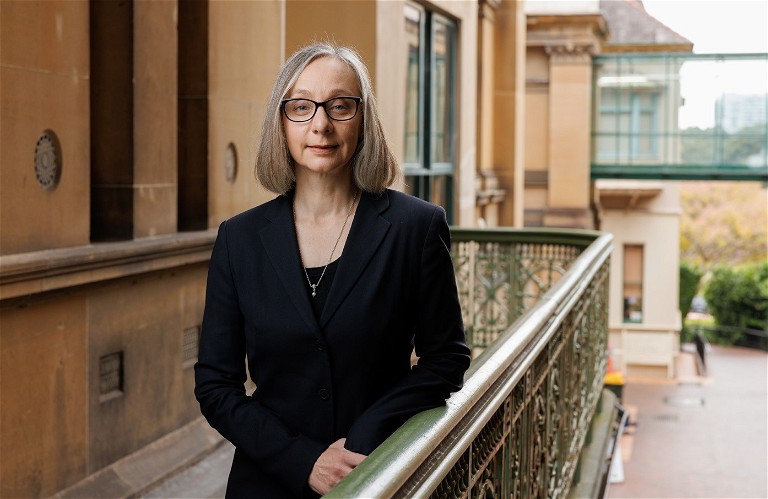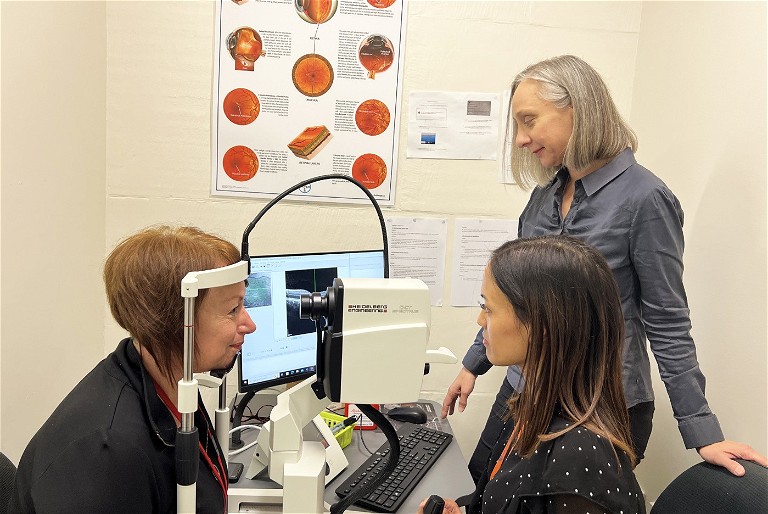mifeature
Behind the Scenes
Empowering Investigators to Save Sight
WRITER Michelle Hauschild

Save Sight Institute
at the Sydney Eye Hospital.
After 20 years, the “mystery” that initially lured Maria Williams into the field of clinical research at the Save Sight Institute (SSI) has long gone. It’s been replaced by a sense of pride at the contribution that SSI is making to improve the lives of people with visionthreatening eye conditions. Michelle Hauschild reports on a remarkable ‘behindthe-scenes’ contribution to ophthalmic research.
There’s been a lot of change since Maria Williams first walked into the Save Sight Institute to become the organisation’s Clinical Research Manager.
“It was a small unit. I was working with Mark Gillies (Professor Mark Gillies, still part of the SSI leadership team, Director of Research, and Director of the Macula Research Group). We had one or two other staff and just a handful of studies.
“We were the main research presence in ophthalmology on the whole campus and back then we didn’t have that much testing equipment.
“So, the participants would have their visual acuity tested and they would have an angiogram, which we took on film, and we would also do some colour photos, and that was the bulk of the testing.”
How things have changed.
Today, the Save Sight Institute, based at the Sydney Eye Hospital, is home to some of Australia’s leading ophthalmologists, researchers, and scientists. It is at the forefront of ophthalmic breakthroughs and is regarded internationally as a centre of excellence in both research and the teaching of ophthalmology.
It also provides specialised clinical services and research in the diagnosis, treatment, and management of eye diseases.
And through all of that “exponential growth”, Ms Williams has been there, carefully coordinating the trials, encouraging researchers, and managing trial participants.
“We have, over the years, been able to establish large complex multidisciplinary teams and implement robust structures and processes in the logistics, administration, and management of clinical trials.
“We are well known for our quality work and sought after as a clinical trials site.
“Although the number of trials can fluctuate, we have periods where the Institute can have over 50 clinical trials concurrently in various stages of activity across the lifespan of the trial,” Ms Williams said.
LAST ON THE LIST
Ms Williams, Honorary Research Associate and Clinical Research Manager, initially trained as a nurse.
“When I graduated as a registered nurse, I had a list of five areas I wanted to use my nursing skills in; paediatrics, aviation, intensive care, with travel, and in clinical research. I have had experience in all those areas and clinical research was the fifth one on the list.
“Research sounded a little mysterious. When I landed my first role at the Garvan Institute of Medical Research, I loved it and I’ve stayed in clinical research for the past 25 years!”
Now at the Save Sight Institute for 20 years, Ms Williams said her role is always busy.
“On any given day I am likely to have multiple calls, conversations, and meetings regarding individual clinical trials or wider overarching issues. Discussions can be local or with larger entities, such as the Ministry of Health or Therapeutic Goods Administration (TGA).
“I am often providing direction, clarification, and advice on processes and procedures, and reviewing a large amount of clinical trial documentation.
“Time can be spent on issues surrounding budgets, contracts, governance, patient safety, and staffing logistics.
“With the introduction of the National Clinical Trials Governance Framework, a significant amount of time is now being taken up working towards accreditation compliance.”
While she cites the “multiple levels of approvals for essentially the same piece of information” as her least favourite part of the job, she is driven by a love of “empowering investigators and clinical research staff with the knowledge and experience in how to run clinical trials effectively”.
LAYING THE GROUNDWORK
Ms Williams said setting up a clinical trial begins with a feasibility process from both the site running the clinical trial and the entity sponsoring or funding the trial. The trial site can also be part of the sponsoring organisation as well as the clinical trial site itself, and this is often the case in SSI’s own investigator-initiated trials.

SSI Clinical Research Manager,
Maria Williams.
“During feasibility, we establish whether the proposed trial is ethically and medically sound. The site and sponsor also assess whether adequate resources and funding are available.
“Once feasibility is established and the site is selected to conduct the study, a review of ethical and clinical research governance is undertaken to seek ethical and governance approval,” Ms Williams explained.
The trial is registered with the TGA during this process, and the site readies itself in terms of completing any special certifications or training required. There’s also a large amount of documentation needed to ensure the trial abides by good clinical practice guidelines.
“When the site is approved to start, the investigational product (drug) is shipped to the site and the study is ready to commence,” she said.
CAREER HIGHLIGHTS
Asked to reflect on a highpoint in clinical research, Ms Williams does not hesitate to nominate the SSI’s work on sight-saving treatments for diabetic retinopathy, still the leading cause of legal blindness in workingage Australians.1
“I was very proud that our unit conducted the first randomised trials that demonstrated that steroids were effective treatments for diabetic retinopathy, even before the vascular endothelial growth factor (VEGF) inhibitors that now dominate the market became available.
“I am, however, most proud of our own BEVORDEX study2 that was the first (and only) head-to-head comparison of VEGF inhibitors and steroids. It showed how to combine them to get the best results for our patients.
“This was not a study that the drug companies were planning to do, but it was cited for many years in optimal practice guidelines.”
“…we have periods where the Institute can have over 50 clinical trials concurrently in various stages of activity across the lifespan of the trial”
She said the “very first randomised controlled trial of intravitreal injections for retinal disease was actually performed through the Save Sight Institute… and we do continue to do lots of intravitreal injection studies”.
“In some of the very early studies, I recall the study participants were required to remain laying down for 30 minutes after the injection. Now the injection itself is a very quick procedure with hundreds of injections being performed every week.”
Anti-VEGF medications, administered through intravitreal injection, are now a mainstream treatment. Before the treatment became widely available in this country in 2007, most people with neovascular age-related macular degeneration (nAMD) lost their vision and often developed legal blindness.
Today they are credited with saving the sight of thousands of Australians. In 2022, an estimated 62,000 Australians were receiving anti-VEGF treatment for nAMD, with 18,000 more receiving the drugs for diabetic macular oedema.3
Partly as a result of the work of research organisations such as SSI, Australia is a world leader in the management of nAMD.4,5
CELEBRATING THE WINS
Ms Williams said the hardest part of the job is “when a drug we test does not work, especially for a condition that has no other treatment”.
“Unfortunately, this has happened in most of the trials of drugs for advanced dry (atrophic) macular degeneration so far.”
On the flip side, she said it is a “great feeling” to know that the Institute has played a role in bringing effective drugs to market.
“It’s a long process. And when we finish a clinical trial, it takes a while for all the data to be analysed and processed.
“So, there is really quite a large lag from when you finished to when you hear about the final results. But in that timeframe, you are already running the next 25 studies, so the focus ends up being on what you’re currently doing.
“Certainly, in my role as a Clinical Research Manager, the focus is on the current studies that you are doing. But it’s really nice to then look back when the results come through and say, ‘Oh, isn’t that great? We enrolled 25 patients in that study’, or however many.
“It’s really, really such a great feeling to know that we’re part of that.”

Ms Williams (standing) with Clinical Research Orthoptist Team Leader Kathleen Agorto (seated, right) examining Heidelberg Spectralis OCT images.
L–R Ms Williams, Ms Agorto, and Quality and Compliance Manager Tommy Groeneveld.
References
1. Macular Disease Foundation Australia, About diabetic retinopathy (web page) available at: mdfoundation.com.au/about-macular-disease/diabetic-eye-disease/aboutdiabetic-retinopathy [accessed April 2024].
2. Gillies, M.C., Lim, L.L., Fraser-Bell, S., et al., A randomized clinical trial of intravitreal bevacizumab versus intravitreal dexamethasone for diabetic macular edema: the BEVORDEX study. Ophthalmology. 2014 Dec;121(12):2473-81. DOI: 10.1016/j.ophtha.2014.07.002.
3. Butler, M., Cheaper medicines from today. Minister for Health and Aged Care (media release, 1 January 2023), available at health.gov.au/ministers/the-hon-mark-butlermp/media/cheaper-medicines-from-today?language=en [accessed April 2024].
4. Rofagha, S., Bhisitkul, R.B., Zhang, K. et al., SEVEN-UP Study Group. Seven-year outcomes in ranibizumabtreated patients in ANCHOR, MARINA, and HORIZON: a multicenter cohort study (SEVEN-UP). Ophthalmology. 2013 Nov;120(11):2292–9. DOI: 10.1016/j. ophtha.2013.03.046.
5. Writing Committee for the UK Age-Related Macular Degeneration EMR Users Group. The neovascular agerelated macular degeneration database: multicenter study of 92 976 ranibizumab injections: report 1: visual acuity. Ophthalmology. 2014 May;121(5):1092–101. DOI: 10.1016/j.ophtha.2013.11.031.
GETTING INVOLVED IN CLINICAL TRIALS
Clinical trials need participants, often with strict guidelines, and Ms Williams said eye health professionals can help by directing appropriate patients to clinical trials.
“Participants in clinical trials are really well supported, so it can also be quite convenient. They can have support with transport to the appointments and back home. And if they’re spending a reasonable amount of time at the site, they can also have meals reimbursed.
“We do have participants who ask us to be in subsequent clinical trials because they really enjoy the process.”
She said some people are motivated to participate by an altruistic desire to further the research, hoping that cures and treatments will be available to future generations.
For others, “perhaps the current treatment for the condition that they have is not optimal… so they may have the opportunity of receiving a better treatment, although we of course can’t guarantee that”.
And, for those who have conditions where there is currently no treatment, the opportunity of a trial may be their only hope.
She said for common conditions, researchers generally recruit participants who can easily travel to the clinical trial site, although for rare conditions, participants will be funded to travel from anywhere in Australia.
“Every single trial has its inclusion and exclusion criteria. So, we are limited in that we can really only enrol based on those criteria.
“We do encourage optometrists and ophthalmologists to get in touch with us if they have a participant who might meet the criteria for one of our clinical trials.
“The staff that interact with the participants do an amazing job.
“I think that just really needs to be recognised and that participants generally have a really positive experience from being in clinical trials… They enjoy the attention they receive and the medical care that they receive. And this very much boils down to the awesome staff that are looking after these participants and the relationships you build with the participants,” Ms Williams said.
Interested eye health professionals can contact the Save Sight Institute for a flyer that lists current enrolling studies. To join the mailing list contact: trials.flyer.clinicians@groups.sydney.edu.au.